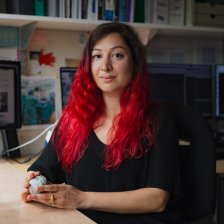Rationale and common goals
Many psychiatric disorders share common neurobiological characteristics both in their etiology and clinical symptoms. This is especially true for disorders characterized by compulsivity, impulsivity, and disturbed attention, such as attention deficit hyperactivity disorder (ADHD), conduct disorder (CD), obsessive compulsive disorder (OCD), autism spectrum disorders (ASD), Tourette syndrome (TS), substance use disorders (SUD), pathological gambling (PG), impulse control disorders (ICD) in Parkinson’s disease (PD), trichotillomania (TTM), body dysmorphic disorders (BDD), and hoarding disorder (HD). Translational, cross-disorder studies with a life span perspective (from early vulnerability to late disease chronicity) may enhance our knowledge and treatment possibilities for a very large and severely impaired group of patients representing a serious burden to families and society as a whole.
Aims
- To establish the developmental aspects of normal variations in impulsivity, compulsivity and attention, transitions to pathology and different stages in the disease course, ranging from the pre-clinical stage to treatment resistance and chronicity.
- To develop novel pharmacological, behavioral, and neuromodulatory treatments using validated translational cross-species models of compulsivity, impulsivity, attention and addictive behavior.
- To optimally target the underlying disease mechanisms of the individual patient with his/her specific behavioral and neural profile and disease stage.
Assets
An important strength is the presence of large patient cohorts, including the Netherlands OCD Association (NOCDA) cohort, the cross-diagnostic cognitive and neuroimaging cohorts at the AMC and VUmc/GGZ inGeest, and the collaboration with important international genetic imaging cohorts such as the ENIGMA initiative. In addition, the group has access to a fully developed set pre-clinical tools (animal SPECT, PET, voltammetry, electrophysiology, and optogenetics), and clinical neuroimaging techniques (3T and 7T MRI, SPECT, PET, PET-MR, EEG, MEG). Furthermore, the group as a unique position in the field of (translational) neuromodulation with frontline research using transcranial magnetic stimulation (rTMS), transcranial direct current stimulation (tDCS), real time fMRI neurofeedback, and deep brain stimulation (DBS). Another strength is the presence of validated translational animal models of compulsivity, impulsivity, attention and addictive behavior that are critical for exploring novel intervention methods. These models are essential in bridging the gap between human genetic and brain imaging studies and pre-clinical studies at the molecular and cellular level. Finally, there are ample opportunities to combine preclinical studies and clinical cohort, neuroimaging and intervention studies with state-of-the-art genetic information.
Making the difference
Uniting preclinical and clinical research on this topic creates a critical mass covering the full translational spectrum from the cell and organ level through cross-species disease models to pharmacological, cognitive and neuroimaging studies in healthy volunteers and patients. This may ultimately lead to the development of new prevention and intervention studies, using pharmacological, behavioral and neuromodulatory techniques. The new program will establish clear definitions and translational research implementation of the concepts of compulsivity, impulsivity and attention with a combination of pre-clinical experiments in rodents (using behavioral pharmacology, chemo- and optogenetics, proteomics and metabolomics) and human studies (using clinical phenotyping, neuropsychological tasks, neuroimaging, and pharmacological and neuromodulation experiments). Apart from developing novel pharmacological and behavioral treatment options, we will innovate in electrical/electromagnetic treatments using new neuromodulation techniques, including (deep) rTMS, tDCS, fMRI neurofeedback and DBS. Some of these new techniques will provide us a more dynamic insight in disease and recovery processes by the use of intracranial recordings and closed loop systems. The ultimate goal is optimal targeting of the underlying disease mechanisms in individual patients with their personal (intermediate) phenotype profile and disease stage.
Program leaders
Taskforce team
Program members
-
 Adria Tunez Aquilue
Adria Tunez Aquilue -
Alfredo Elhazaz Fernandez
-
 Allison McDonaldMSc
Allison McDonaldMSc -
Amy Tedja
-
Anders Thorsen
-
Andries Poortman
-
Anna Domen
-
 Anneke GoudriaanPI Prof. PhD
Anneke GoudriaanPI Prof. PhD -
 Anouk SchranteePI DR.
Anouk SchranteePI DR. -
Bart CornelissenMSc
-
 Cees WeelandDR.
Cees WeelandDR. -
Chaya Rodrigues Pereira
-
Cheima Bouziane
-
Chris de Kock
-
 Chris VriendPI DR. PhD
Chris VriendPI DR. PhD -
Conrado Arturo Bosmandr. M.D.
-
 D RietveldPI PhD
D RietveldPI PhD -
 Damiaan DenysPI PROF.DR.
Damiaan DenysPI PROF.DR. -
Danae Mitsea
-
Danai Riga
-
Daniëlle PosthumaPI PROF.DR.
-
Dirk SmitPI DRS.
-
Emily Poort
-
Esther van Duin
-
Eugenia Poh
-
 Gianina Cristian
Gianina Cristian -
Giulia Agnello
-
 Guido van WingenPI Prof. PhD
Guido van WingenPI Prof. PhD -
 Henny VisserDR.
Henny VisserDR. -
Hilgo BruiningPI DR.
-
 Ilja SarisDRS.
Ilja SarisDRS. -
Ilse Graat
-
 Inge Jager
Inge Jager -
 Ingo WilluhnPI MSc PhD
Ingo WilluhnPI MSc PhD -
Isabell EhmerMSc
-
 Isidoor BergfeldDR.
Isidoor BergfeldDR. -
Jan BooijPI DR.
-
Jasper Zantvoord
-
Jessica Goedhoop
-
 Jorien TreurPI
Jorien TreurPI -
Judith Ensink
-
 Judy LuigjesPI MSc
Judy LuigjesPI MSc -
 Karin VerweijPI Prof. PhD
Karin VerweijPI Prof. PhD -
Katy van GalenDRS. DRS.
-
Laura TsengMSC.
-
Lennart CornelissePI PhD
-
 Liesbeth RenemanPI PROF.DR.
Liesbeth RenemanPI PROF.DR. -
Lizz Fellinger
-
 Lucres Nauta-JansenPI Prof. dr. PROF.DR.
Lucres Nauta-JansenPI Prof. dr. PROF.DR. -
Maik Derksen
-
Maj GigengackMSC. MSC.
-
Manon KappelhofDRS.
-
Mara van der HoevenMSc
-
 Margot van de Weijer
Margot van de Weijer -
Marleen Olthof
-
Marloes OudijnMD
-
Marthe van der Pol
-
Martijn van den HeuvelPI DR.
-
Matthijs VerhagePI PROF.DR.
-
Melisse Bais
-
Michel van den Oever
-
Mirjam de Kroo
-
Monja Hoven
-
Muhannad Smadi
-
Myrle Stouten-KempermanMSc
-
Nadine Eijsker
-
Nadza Dzinalija
-
 Nathan MarchantPI Dr.
Nathan MarchantPI Dr. -
Nienke VulinkDR.
-
 Odile van den HeuvelPI PROF.
Odile van den HeuvelPI PROF. -
 Patricia van OppenPI PROF.DR.
Patricia van OppenPI PROF.DR. -
Pelle de KoningMD PhD
-
Pelle Wilbers
-
Petra Walta
-
 Priyanka Rao
Priyanka Rao -
Rhiannon RobkeMSc
-
 Ruth van HolstPI PhD
Ruth van HolstPI PhD -
 Sabine Spijker
Sabine Spijker -
 Taco de VriesPI PROF.DR.
Taco de VriesPI PROF.DR. -
 Tara ArbabMSc
Tara ArbabMSc -
 Tinca PoldermanPI DR.
Tinca PoldermanPI DR. -
Tjardo PostmaMSC.
-
 Tommy PattijPI DR.
Tommy PattijPI DR. -
Vionna TsangMSc
-
 VM HeinePI PROF.DR.
VM HeinePI PROF.DR. -
Wieke van Leeuwen
-
Willem Bruin
-
Willem van den BrinkPROF.DR.
-
Wouter van Elzelingen
-
Yak Mee Wong
-
Ysbrand van der WerfPI PROF.DR.




